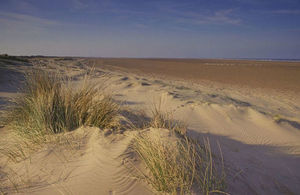Threatened sand dunes given a new lease of LIFE
Major sand dune conservation project awarded £4.3 million of funding

Sand dunes across England are set for a golden future following £4.3 million worth of funding to help restore and protect these at risk habitats.
The funding - awarded to a partnership led by Natural England as part of the European Union’s LIFE programme - will help deliver a major conservation project to explore how to re-establish the natural movement within dunes and create the conditions that some of our rarest wildlife relies upon.
Healthy sand dunes with moving sand are a sanctuary for endangered plants and animals like the natterjack toad, dune gentian and sand lizard. However these habitats are currently being smothered and fixed by a tide of invasive non-native plants turning it into scrubland. Sand dunes are now one of the most at risk habitats in Europe. Only 20,000 hectares remain across England and Wales – an area around half the size of the Isle of Wight.
The DuneLIFE project will help Natural England improve the condition of key sand dune sites in Lincolnshire, Dorset, Cornwall, Devon, Merseyside and Cumbria by tackling the root causes of decline. The scheme will:
- Deliver a programme of removal of invasive species to rebalance the natural processes of dune colonisation
- Restore sand dunes and dune slacks
- Create bare sand patches by turf stripping and sand scraping
- Encourage more people to access and enjoy dunes and take part in their conservation
Natural England are working in partnership with Plantlife, National Trust and the Wildlife Trusts to deliver this ambitious and innovative project.
Chairman of Natural England, Andrew Sells, said:
This is a wonderful project to help save our sand dunes and promote a better understanding of this fascinating landscape.
Sand dunes are a familiar backdrop to a day at the beach, but few people realise the serious threat they face across Europe. I am delighted that we have this exciting opportunity to work with our partners to safeguard these wildlife-rich habitats for future generations.
Marian Spain, Plantlife Chief Executive, said:
Nestling often undetected in the dunes are a treasure chest of wildflowers and wealth of wildlife jewels.
Re-enlivening sand dunes - much of them now suffocated under a blanket of thick grass and scrub - is urgent if we are to save dune flowers such as the plucky little fen orchid from extinction. Purple milk-vetch and dune gentian, two other rare dune gems, face an increasingly uncertain future without the help of this exciting project. And the really great news is that everybody who visits the dunes can make a difference: we know now that trampling feet is a great way to free up space for rare plants.
While millions either live in coastal communities or visit the seaside every year it is sadly little-known that dunes are listed as the habitat most at risk in Europe. This project can transform their future by inspiring and promoting a better understanding of their value to wildflowers, wildlife and people.
David Bullock, Head of Nature Conservation at the National Trust, said:
Sand dunes are amongst the most threatened landscapes in Europe because we have sought to stabilise them and also they have been invaded by non-native vegetation.
The windblown sand spaces that the special animals and plants need to survive are no longer there.
This project will create new open blown patches of sand and we hope not to just connect nature with nature; but people with nature and sand dunes as well.
Stephanie Hilborne OBE, CEO of The Wildlife Trusts, said:
Everyone should have the opportunity to experience the joy of standing amidst a sand dune. These are wild places and when you stand amongst the marram grass and sea holly, listening to the sound of the surf and the call of the stonechats you may look up to see a raven wheeling above.
Our sand dunes don’t just provide wildlife with a home, and us with such experiences but they act as a natural flood defence. So this partnership is an exciting new development given that so many of our dunes are in trouble.
We are looking forward to helping people breathe new life in to our dunes from Cumbria to Cornwall and across to Lincolnshire. Thanks to funding from the EU LIFE programme there is a great chance to help many people work together to change the natural world for the better.
This successful LIFE bid marks an important step towards a larger programme of sand dune conservation work around the coast of England and Wales which has already gained initial support for over £4 milllion of National Lottery funding from the Heritage Lottery Fund (HLF).
Natural England are working in partnership with Natural Resources Wales, Plantlife, National Trust, and The Wildlife Trusts, to deliver this ambitious project.